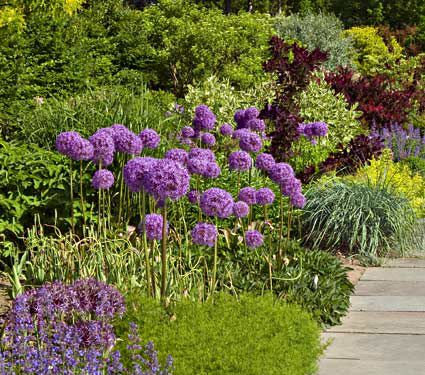






Allium - Show-stopping globes, spheres, and domes for your garden
It's unfortunate that this handsome and distinctive genus bears the common name of Flowering Onion because beginning gardeners may receive the wrong impression and forgo some of the most elegant and sculptural blossoms found in the world of plants. The majority of Alliums bear statuesque, globe-shaped flower heads on long straight stems and offer a texture and form this is unique and therefore extremely useful in practically any garden design. Allium blooms are interesting before they open, glorious in full bloom, and attention getting even after they've gone by. Flower heads vary from huge (such as Allium 'Globemaster' with 8–10″ flower heads) to tiny and are lovely both in the garden and in a vase. The range of colors is choice, from true blue, dark purple, pink, and yellow to white.
It is worth mention that Alliums, like Daffodils, are deer and rodent resistant, thanks to their faint oniony scent. The odor is not noticeable above the ground unless the leaves are cut or bruised and many of the flowers have an enchanting, sweet scent. There are hundreds of species within this delightful and under-appreciated genus, and we have struggled to restrain ourselves to a reasonable selection. They are reliable perennials when they get good drainage and plenty of sun.
Using Alliums in the garden
Alliums offer colorful, distinctive, and long-lasting flower forms that are standouts in the early summer garden (there are some fall bloomers as well). They love sun and prefer a well-drained, even sandy, soil as long as it has sufficient nutrients. Tuck the bulbs around clumps of summer-flowering perennials where the Alliums' withering foliage will be hidden by the expanding perennials. Some combinations we use at the nursery include Allium 'Globemaster' among Echinacea (Purple Coneflower); Allium sphaerocephalon (the Drumstick Allium) with Yarrow, Asiatic Lilies, or Phlox; and Allium cristophii (Star of Persia) with Salvia 'May Night,' Alchemilla mollis (Lady's Mantle), or Roses. We offer 5 varieties of the shorter Alliums (10–30″ tall) as A Big Mix of Little Alliums. They look best along the edge of a shrub border or planted in front of late-blooming perennials.
What We Ship
We send premium, top-quality bulbs in fall, at the correct time for outdoor planting in your region.
Allium - How to Care for Your Bulbs
Light/Watering: Most Alliums grow best in full sun, with at least 6-8 hours of direct sun a day. Those we offer require well-drained soil and are longest lived in locations where the soil is on the dry side during summer dormancy.
Planting: Plant Alliums more shallowly than comparably sized bulbs, just one to two times the diameter of the bulb deep.
Fertilizer/Soil and pH: Alliums prefer well-drained, fertile soil. Fertilize in fall and spring with any bulb fertilizer.
Continuing Care: The leaf tips of many varieties, especially the tall ones, begin to brown before bloom time. Remove the spent flowers (except from varieties that are sterile, such as 'Globemaster') if you wish to prevent them from self-sowing.
Pests/Diseases: Alliums have few problems except when planted too shallowly or in wet soil.
Companions: Place Alliums behind heavy-foliage plants such as Peonies and Iris. Good for bedding, and in mixed borders. Flower heads are good for drying.
Dividing/Transplanting: Alliums rarely need transplanting or dividing, but this can be done when the bulbs are dormant.
Copyright © www.100flowers.win Botanic Garden All Rights Reserved